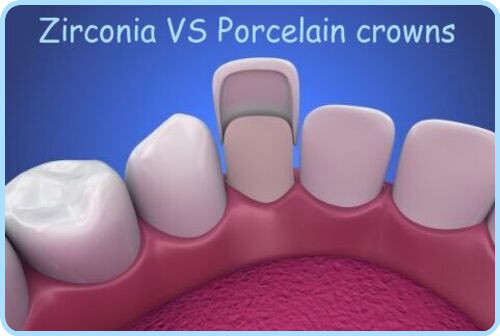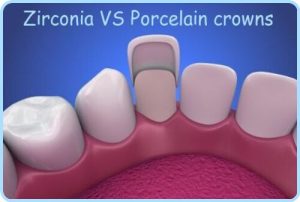Zirconia vs porcelain crowns
Let’s do a comparison and look at Zirconia vs Porcelian crowns so that you have all the information that you need on dental crowns
In dentistry crowns are often used to cover badly shaped or misaligned teeth, there are different types of dental crowns including Zirconia and porcelian crowns.
Zirconia and porcelain crowns are both popular options for dental restorations, but they have some differences to consider when choosing between them.
Porcelain crowns are made of a type of ceramic material that closely mimics the natural look and feel of teeth.
They are typically used for front teeth because of their aesthetic appeal and ability to blend in seamlessly with surrounding teeth.
Zirconia, on the other hand, is a type of metal that has been infused with ceramic to increase its strength and durability.
Zirconia crowns are often used for back teeth because of their resistance to wear and tear.
Advantages and disadvantages
Both types of crowns have their advantages and disadvantages, and the choice ultimately comes down to the specific needs and preferences of the patient.
Porcelain crowns tend to be more fragile than zirconia and may require more maintenance over time, while zirconia crowns can be more difficult to customize for color matching.
If you are considering either type of crown, it is important to discuss your options with a trusted dental professional who can guide you in choosing the best option for your unique situation.
Zirconia dental crowns have become increasingly popular due to their durability, aesthetics and biocompatibility.
However, like any dental procedure, there are both advantages and disadvantages to consider.
Additionally, the cost of zirconia dental crowns can vary depending on where the procedure is done.
In this article about Zirconia vs Porcelian crowns we will compare the advantages, disadvantages and cost of zirconia dental crowns in Ireland versus Hungary.
Advantages of Zirconia Dental Crowns:
– Durability: Zirconia dental crowns are known for their strength and resistance to wear and tear.
– Aesthetics: Zirconia is a tooth-colored material, making it an ideal choice for those who value a natural-looking smile.
– Biocompatibility: Zirconia is biocompatible, meaning it is less likely to cause an allergic reaction or irritation.
– Minimal Tooth Preparation: Zirconia dental crowns require less tooth preparation compared to other restorations, such as porcelain-fused-to-metal crowns.
Disadvantages of Zirconia Dental Crowns:
– Cost: Zirconia dental crowns tend to be more expensive than other types of crowns.
– Difficulty in Adjusting: Zirconia crowns are difficult to adjust once cemented in place due to their strength, so careful planning and precision is required in the initial placement.
– Possible Sensitivity: Zirconia crowns can cause tooth sensitivity in some patients.
Cost of Zirconia Dental Crowns in Ireland versus Hungary:
The cost of zirconia dental crowns in Ireland ranges from €500-1500 per tooth, depending on the dentist and location.
In Hungary, the cost is generally lower, ranging from €300-1000 per tooth, to fi d out more about the cost of Zirconia crowns in Hungary contact us at Hungarian dental Implant Centre Wexford.
To find out how you can save money and get a dental plan that includes the price for Zirconia crown vs porcelian crowns why not contact us at Hungarian Dental Implant Centre Wexford.
However, it is important to research and choose a reputable dentist to ensure the quality of the procedure and materials used.
In conclusion, zirconia dental crowns offer many advantages, including durability, aesthetics, biocompatibility, and minimal tooth preparation.
However, the cost can be a disadvantage, with the price in Ireland being generally higher than in Hungary.
It is important to carefully consider all factors when deciding whether zirconia dental crowns are right for you, including the advantages, disadvantages, and cost, and to choose a reputable dentist.
For more information on the cost of Zirconia vs porcelian crowns contact us at Hungarian Dental Implant Centre Wexford.
Porcelain dental crowns are a popular choice for people looking to repair damaged or decayed teeth.
They are known for their durability, natural appearance, and ability to match the surrounding teeth.
However, like any dental procedure, there are advantages and disadvantages to porcelain dental crowns.
Advantages of Porcelain Dental Crowns:
1. They look so natural: Because porcelian crowns are custom made and are a perfect match for the size, colour and shape of the patient’s natural teeth making them identical to real teeth.
2. Durability: Porcelain dental crowns are extremely strong and can last for many years, especially when taken care of properly.
3. Stain-resistant: Porcelain crowns are resistant to staining from foods and drinks, which makes them an ideal choice for people who want to maintain a bright, white smile.
Disadvantages of Porcelain Dental Crowns:
1. Cost: Porcelain dental crowns are more expensive than metal or composite resin alternatives.
2. Sensitivity: Some people may experience temporary sensitivity to hot and cold foods and drinks after getting a porcelain crown.
3. Brittle: Porcelain crowns are more brittle than metal crowns and can crack or chip under certain circumstances.
In Ireland, the cost for a porcelain dental crown can range from €500 to €1,000 per tooth, depending on the dental clinic and the type of crown used.
However, in Hungary, the cost for a porcelain dental crown can be significantly lower, with prices ranging from €200 to €400 per tooth.
It’s important to note that while the cost of porcelain dental crowns may be cheaper in Hungary, there are additional costs associated with traveling overseas for a dental procedure.
This could include travel expenses, accommodations, and potential language barriers.
Conclusion
Thank you for reading this article on Zirconia vs porcelain crowns.
Ultimately, the decision to get a porcelain dental crown should be based on a consultation with a qualified dentist and an assessment of one’s personal needs and budget.
References


